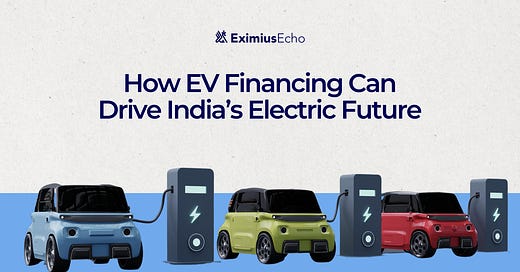How EV Financing Can Drive India’s Electric Future
Exploring the role of financing in India's EV transition amidst policy shifts, market challenges, and evolving consumer value perceptions.
Hi there,
This week on Eximius Echo, we’re exploring the pivotal role of financing in India’s EV journey. With ambitious 2030 targets, affordable EV financing could make all the difference, yet the path is complex, marked by regulatory shifts and lender caution. Read along as we unpack the challenges and opportunities that could shape the future of India’s electric mobility.
Electric vehicles (EVs) have generated immense excitement in India in recent years, marking what many see as a revolution in the automobile industry. The government has set ambitious targets, aiming for 30% EV penetration by 2030, encouraging a surge of interest across stakeholders from OEMs to fleet operators, and even deep-tech solutions focused on battery optimization. Yet, as India moves closer to this target, one aspect is proving critical: EV financing. With the EV financing market estimated to exceed $50 billion by 2030, it’s touted as a major catalyst for the transition. But does this immense potential come with equally significant challenges?
The State of India's EV Industry
The growth of EV financing is intrinsically tied to the broader EV market in India. Policies set by the government have been instrumental, but the initial enthusiasm is beginning to wane. While early initiatives like the FAME (Faster Adoption and Manufacturing of Electric Vehicles) scheme provided substantial support, recent allocations in the union budget have focused on settling FAME II liabilities, with limited new funding for expansion. An announcement of a FAME III program offers some hope, but the actual impact will depend on the scale of future allocations.
Beyond government support, other barriers persist. For consumers and investors alike, a key question remains unanswered: What’s the value proposition of EVs compared to ICE (internal combustion engine) vehicles? While EV penetration in India stands at around 5.7%, this figure is skewed: 80% of EV sales are in the two- and three-wheeler segment, leaving passenger vehicles with a modest 2% penetration rate. This disparity highlights the need for a stronger consumer case for EVs, especially for those considering alternatives to ICE vehicles.
The cost difference is another sticking point. For example, the Ola S1 Pro scooter costs around INR 1.29 lakh, compared to approximately INR 80,000 for a similar ICE scooter. This gap widens for cars, where EVs are typically INR 2-6 lakh more expensive than their ICE counterparts. While the cost of EV technology will likely decrease over time, this price delta is a deterrent for many potential buyers.
The perceived long-term savings of EVs due to lower operating costs are attractive but require high usage to be realized. For individual consumers who mainly drive short city distances, the benefits may feel negligible. Commercial fleets, however, may see these savings more tangibly—though even here, the initial premium can be a hurdle.
The Role of EV Financing in Boosting Adoption
Addressing the price challenge is where EV financing could play a game-changing role. By offering tailored financial solutions, EV financing could make EVs more accessible and affordable, particularly for consumers put off by high upfront costs. However, despite the promise, several barriers currently impede the development of a robust EV financing ecosystem.
Perceived Risk and Limited Financial Products: Given the industry’s nascency, many lenders are cautious about the uncertainties tied to EV technology and the market’s growth trajectory. This results in higher interest rates (2-15% above ICE vehicle loans), higher down payments, and shorter loan tenures, usually between 6-24 months.
Limited Participation from Large Banks: Major banks are hesitant to enter the EV financing space due to perceived risks, leaving non-banking financial companies (NBFCs) and smaller banks to meet demand. This lack of participation from larger players reduces the variety of financing options and generally leads to a higher cost of capital for borrowers.
Weak Second-Hand Market: A robust resale market for EVs has yet to develop, which adds to lenders’ worries about resale values and loan recoveries. This makes EV loans less attractive and keeps lending terms restrictive.
OEM Reliability Concerns: The fast-evolving EV sector has seen the emergence of numerous OEMs, many of which are financially unstable, leading to shutdowns and high default rates. This volatility pushes lenders to favour the few well-established brands, limiting options for consumers interested in emerging EV models.
The Path Forward: Policy and Innovation
With the initial EV excitement cooling, the sector must now tackle these obstacles to build long-term stability. A coordinated effort involving both government and industry players is essential for success. Policy measures could help alleviate financing challenges; for example, if the Reserve Bank of India were to designate EVs under priority sector lending, it could unlock more favourable terms from larger banks and expand financing options.
Private-sector innovation is also crucial. New startups in EV financing, like Vidyut Tech and Revfin, have started developing innovative solutions, using technology to improve loan accessibility and affordability for EV buyers. Their initiatives provide a glimpse of what the sector might look like with more advanced financial products tailored to EV ownership.
Conclusion
The journey toward widespread EV adoption in India is both promising and challenging. While EV financing holds substantial potential to ease adoption hurdles, the sector’s success will depend on collaborative efforts to overcome current limitations. Effective policies and financing innovation, combined with stable, trustworthy OEMs, will be pivotal in driving growth. With the right support, EV financing could unlock vast new possibilities for the Indian market, accelerating the transition to electric mobility. For now, though, both the EV industry and its financing ecosystem face a long road filled with bumps, detours, and opportunities for growth.
If you're building in this space, we’d love to hear from you. Please reach out to us at pitches@eximiusvc.com.






